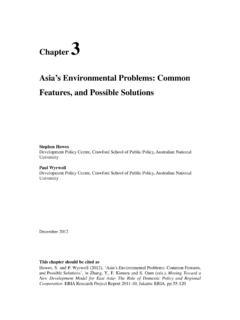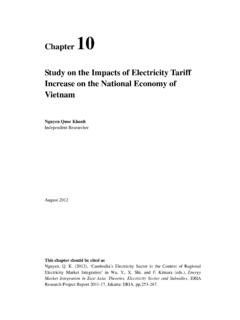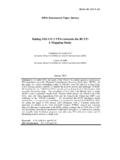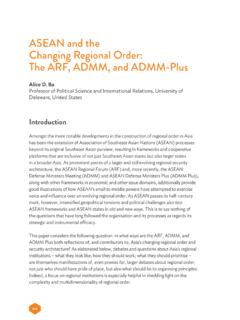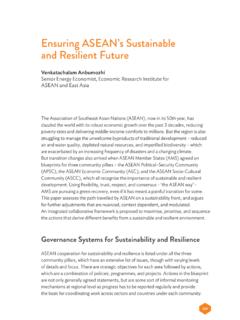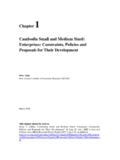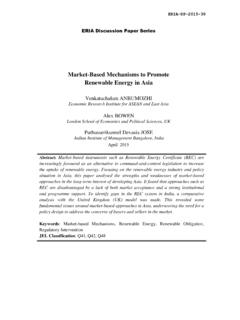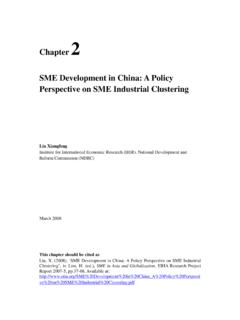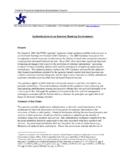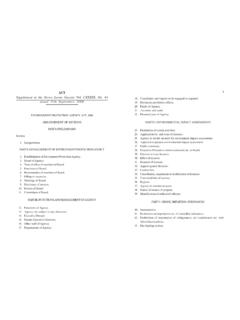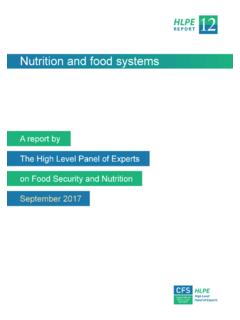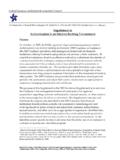Transcription of Impacts of Natural Disasters on Agriculture, Food Security ...
1 ERIA-DP-2013-15 ERIA Discussion Paper Series Impacts of Natural Disasters on agriculture , food Security , and Natural Resources and environment in the Philippines DANILO C. ISRAEL Philippine Institute for Development Studies ROEHLANO M. BRIONES Philippine Institute for Development Studies August 2013 Abstract: This study quantitatively and qualitatively analyzed the Impacts of Natural Disasters (particularly typhoons, floods and droughts) on agriculture , food Security and the Natural resources and environment in the Philippines. It aimed to propose recommendations as to how best to respond to the Impacts of Natural Disasters and to suggest further studies that can be undertaken. In general, the study found that: a) typhoons, floods and droughts have an insignificant impact on overall agricultural production at the national level, yet typhoons may have a significant negative impact on paddy rice production at the provincial level; b) typhoons, as exemplified by Ondoy and Pepeng in 2009, have a significant negative impact on the food Security of the households in the affected areas; c) households have varying consumption and non-consumption strategies to cope with the Impacts of typhoons; and d) the different Impacts of typhoons, floods and droughts on the Natural resources and environment have not been quantitatively assessed in detail, however available evidence suggests that these are also substantial.
2 Based on its results and findings, the study recommends the following: a) Since typhoons may have significant negative Impacts on rice production at the local level as opposed to the national level, assistance for rice farmers and the agriculture sector as a whole should be made more site-specific, zeroing in on the affected areas that actually need it; b) Those assisting affected households and areas in overcoming the resulting ill-effects of Natural Disasters should consider not only consumption strategies, such as the provision of emergency food aid, but also non-consumption strategies, such as the provision of post- disaster emergency employment; and c) While the available evidence suggests that the Natural resources and environment sector is significantly affected by Natural Disasters , it is currently less considered, as attention is presently focused on agriculture .
3 It may now be high time to provide concrete assistance to this sector, in particular the provision of defensive investments and rehabilitation expenditures to cope with these Natural Disasters . Keywords: Naturaldisasters, typhoons, floods, droughts, agriculture , food Security , Natural resources and the environment , Agricultural Multi-Market Model for Policy Evaluation (AMPLE) JEL classification: Q54, Q51, Q15, Q18, O53 1 1. Introduction In Southeast Asia, the Philippines is among the hardest hit by Natural Disasters , particularly by typhoons, floods and droughts. These Natural Disasters have negative economic and environmental Impacts on the affected areas and the people who live there. Furthermore, the agriculture and Natural resources sectors are highly vulnerable because they are continuously exposed to Natural Disasters and their unwelcome consequences.
4 An analysis of the Impacts of typhoons, floods and droughts on agriculture , food Security and the Natural resources and environment of the Philippines will help bring further to light the nature and extent of these effects. For an economy largely dependent on agriculture and its Natural resources and environment , the data and information as well as overall knowledge gained from the study may prove useful in developing strategies to address the ill-effects of Natural Disasters . Moreover, the results and findings may assist in identifying new studies that can soon be undertaken in relation to Natural Disasters , an important research concern which still lacks the necessary level of focus in the Philippines. The main objective of this study is to quantitatively and qualitatively analyze, to the extent possible with available secondary data and information, the Impacts of typhoons, floods and droughts on agriculture , food Security and the Natural resources and environment in the Philippines.
5 The specific objectives are to: a) present an overview of agriculture , Natural resources and environment , disaster management, and the occurrences of typhoons, floods and droughts in the country; b) evaluate the Impacts of typhoons, floods and droughts on agriculture at both the national and provincial level; c) assess the Impacts of these Disasters on food Security ; and d) analyze the effects of these Disasters on the Natural resources and environment . The ultimate aim for doing so is to recommend measures that can be undertaken in response to the unwelcome Impacts of Natural Disasters on the agriculture and Natural resources and environment sectors and to propose relevant studies that can be undertaken in the future. 2 2. Methodology Definitions Put simply, a Natural disaster is a Natural event with catastrophic consequences for living things in the vicinity (Sivakumar, 2005).
6 From an economic perspective, a Natural disaster can be taken as a Natural event that causes a perturbation to the functioning of the economic system, with significant negative impact on assets, production factors, output, employment, or consumption (Hallegatte and Przyluski, 2010). In the Philippines, the Philippine Atmospheric, Geophysical and Astronomical Services Administration (PAGASA), which is the institution that provides meteorological, astronomical, climatological and other specialized data and information and services, defines a disaster as a serious disruption of the functioning of a community or a society involving widespread human, material, economic or environmental losses and Impacts which exceeds the ability of the affected community or society to cope using its own resources.
7 On the other hand, it defines a hazard as a dangerous phenomenon, substance, human activity or condition that may cause loss of life, injury or other health Impacts , property damage, loss of livelihood and services, social and economic disruption, or environmental damage . Natural Disasters are generally meteorological, hydrological, geological or biological. Examples of meteorological and hydrological Disasters include typhoons, floods and droughts. A typhoon is the name given to a storm system that occurs in and around the Philippines and Southeast Asia (elsewhere commonly known as a cyclone or hurricane, depending on the location). According to PAGASA, a typhoon is a tropical cyclone with winds that exceed 118 kilometres per hour that occurs in the western Pacific . A flood is defined as an abnormal progressive rise in the water level of a stream that may result in the overflowing by the water of the normal confines of the stream with the subsequent inundation of areas which are not normally submerged.
8 On the other hand, a drought is defined as abnormally dry weather in a region over an extended period of time . 3 food Security is a situation that exists when all people, at all times, have physical, social and economic access to sufficient, safe and nutritious food that meets their dietary needs and food preferences for an active and healthy life (FAO, 2002; 1996). The basic features of food Security are accessibility, affordability and absorption (Kurien, 2004). This means that, firstly, food should not only be in sufficient quantity, it must also be actually accessible to people of all economic classes and in all locations. Secondly, its supply should also be stable so that it is affordable in both the short and long term. Thirdly, and equally importantly, food should be absorbable and safe for people to consume.
9 Framework of Analysis Theoretically, the Impacts of Natural Disasters on agriculture and the Natural resources and environment sectors can be direct or indirect as well as positive or negative (Figure 1). In the case of agriculture , the direct and positive Impacts are actually readily identifiable. Typhoons increase the supply of water for agriculture as they usher in rain. Floods improve soil fertility as they deliver nutrients from the uplands to the lowlands. In addition, floods temporarily create a larger water habitat for inland fish and other aquatic animals. Together with other yet-to-be-identified factors, these Impacts of typhoons and floods are viewed as positive because, ceteris paribus, they facilitate an increase in agricultural production in the affected areas and help improve the food Security situation. In contrast to the above, there are direct and negative Impacts of Natural Disasters on the agriculture sector as well.
10 Typhoons, floods and droughts have the potential to reduce farm productivity; damage farm inputs, facilities and/or infrastructure, and limit farm planting options. Furthermore, individually, typhoons and floods can damage farm supply routes and cause death or injury to farm workers. As a consequence, these direct and negative factors can further lead to indirect and negative Impacts on agriculture and the economy as a whole. Specifically, as a result of typhoons, floods and droughts, the overall cost of agricultural production increases; agricultural production output declines; food supply falls and, as a result, food prices rise. Taken together, the direct and indirect negative Impacts on agriculture threaten food Security in the affected areas. 4 Figure 1: Framework of Analysis on the Impacts of Natural Disasters on agriculture , food Security , and the Natural Resources and environment (NRE) soil erosion (typhoons and floods) reduced ra inf a ll(droughts) siltation and sedimentation (f loods) reduced tree a nd vegeta tive cover (typhoon, floods and droughts) red u ced so il f ert ilit y (droughts)accumula tion of wa stes and water pollution(f loods) saltwater intrusion (droughts) higher tides and storm surges (typhoons and floods) deformed topography ofla n d (f lo o d s) othersAgricultureNREN atural Disasters (Typhoon, Floods, and Droughts)- increa sed m oisture(typhoons and floods)-reduced air pollution(typhoons)-othersDirect ImpactsIndirect ImpactsDirect ImpactsIndirect Impacts reduced farmProduction (all)-da m a ged f a rm in p u t s, f a cilit ies and/or infrastructure (a ll)-lim ited f a rm p la n t in goptions (all)
